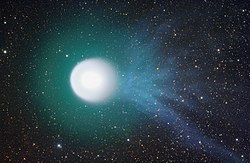17P / Holmes
| 17P / Holmes [i] | |
|---|---|

|
|
| Properties of the orbit ( animation ) | |
| Orbit type | short-term |
| Numerical eccentricity | 0.435 |
| Perihelion | 2.053 AU |
| Aphelion | 5.181 AU |
| Major semi-axis | 3,617 AU |
| Sidereal period | 6 a 321 d |
| Inclination of the orbit plane | 19.113 ° |
| Perihelion | May 4, 2007 |
| Physical properties of the core | |
| Medium diameter | 3.4 km |
| history | |
| Explorer | Edwin Holmes |
| Date of discovery | November 6, 1892 |
| Older name | 1892 V1, 1892 III, 1892f, 1899 L1, 1899 II, 1899d, 1906 III, 1906f, 1964 O1, 1964 X, 1964i, 1972 I, 1971b, 1979 IV, 1979f, 1986 V, 1986f, 1993 VII, 1993i |
| Source: Unless otherwise stated, the data comes from JPL Small-Body Database Browser . Please also note the note on comet articles . | |
17P / Holmes is a periodic comet of the Jupiter family . The comet's orbit runs between Mars and Jupiter with an orbital period of about seven years.
Discovery story

On November 6, 1892, the British amateur astronomer Edwin Holmes discovered a comet near the Andromeda Nebula shortly before midnight, the exact position of which, however, could only be determined after midnight due to the dense cloud cover - this fact leads to the fact that November 7th is also possible is specified as the time of discovery.
The comet was visible to the naked eye for the entire month of November. In mid-January 1893 the comet was only an object of about 10th magnitude before its brightness once again reached the 8th magnitude. Since the comet never comes closer to the sun than the planet Mars , the discovery can be traced back to an outbreak of brightness.
In 1899 and 1906, 17P / Holmes returned to the part of its orbit closest to the sun, whereby it remained an extremely faint object. After 1906 it was no longer found and was considered lost for a long time. In 1963, based on new orbital calculations , Brian Marsden came to the conclusion that the comet's orbit must have changed. With the new orbit data, 17P was found again in 1964 and has been observed regularly since then.
2007 eruption of brightness
On May 4, 2007, 17P again reached the point of its orbit closest to the sun. Since then its brightness had dropped to below 16 mag . In the early morning of October 24, 2007, an observer in Tenerife reported that the comet was much brighter than expected. Shortly thereafter, Bob King estimated the brightness from Minnesota to be 7.1 mag. A few hours later the same observer could see it with the naked eye as an object of 4th magnitude. Another 6 hours later, Japanese and Italian observers stated a brightness of 2.8 mag; On the night of October 24-25, 2007, 2.6 mags were reported from North America. 17P has increased its brightness by 500,000 times within a very short time. Since the outbreak, the coma has increased in diameter by 97,000 km / day; H. the radius changes by 0.56 km / s (November 7, 2007). On November 9th, 17P was the largest object in the solar system with its tail before the sun.
The cause of this eruption can be a collision with a larger boulder, the surface rupturing or even the breaking of the comet's core. As a result, large amounts of dust are released. As shown in spectroscopic analyzes, sunlight is reflected on this material. However, a specific trigger that released the dust is not known.
At the beginning of November 2007, 17P / Holmes was 1.60 AU (242 million km) from Earth and was found in the constellation Perseus . A slightly yellowish “nebula” could be seen with the naked eye. In the telescope a whitish coma in the center and a greenish coma in the outer area with an apparent diameter of around 40 arc minutes was visible (true diameter more than 2 million kilometers). In the further course, 17P developed a tail that was already recognizable with strong field glasses ; this appeared very briefly at the time because it points almost exactly away from the earth. Holmes' brightness was unchanged on November 5, 2007 at around 2.5 mag, with a very slight downward trend. On November 20, 2007, it had already reduced its brightness to 3.1 mag.
The comet was still observable in February 2008. However, the brightness had dropped to magnitude 5.0.
See also
Individual evidence
- ^ Edwin Holmes: Discovery of a new comet in Andromeda. In: The Observatory. Vol. 15, 1892, pp. 441-443, bibcode : 1892Obs .... 15..441H .
- ↑ a b Komet shines 500,000 times brighter - Article at www.spiegel.de
- ↑ Comet Holmes Bigger Than The Sun ( Memento from March 5, 2008 in the Internet Archive )
- ↑ Comet Holmes is as bright as the moon - article at www.welt.de
- ↑ a b Comet 17P / Holmes can still be seen with the naked eye - article at www.suw-online.de
- ↑ Comet 17P / Holmes at astronomie.info
- ↑ Comet 17P / Holmes ( Memento from April 30, 2008 in the Internet Archive )
- ↑ Burkhard Leitner's search card . Retrieved December 17, 2010.
literature
- A blast in Perseus (interview with comet researcher Herrmann Böhnhardt from the MPI for Solar System Research ), Astronomie heute , Jan / Feb (2008), pp. 49–52, ISSN 1610-8728

